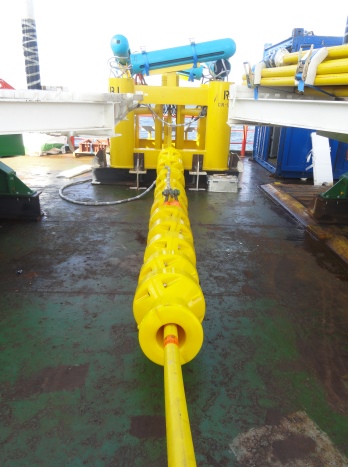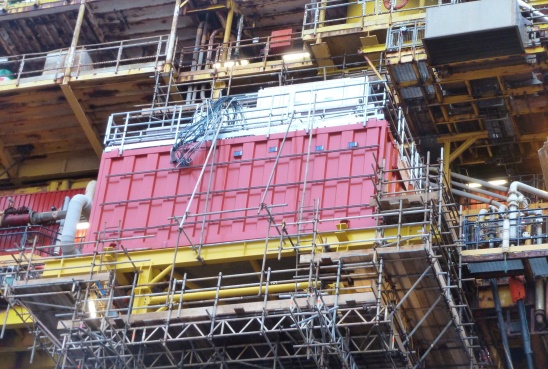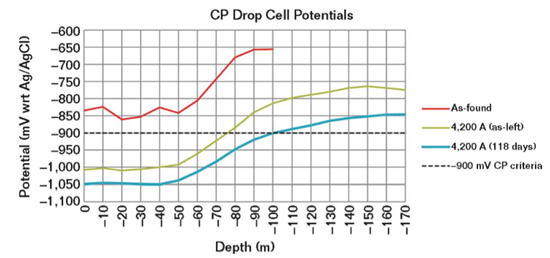The North Cormorant oil and gas platform, owned and operated by TAQA, a wholly owned subsidiary of Abu Dhabi National Energy Co. (a diversified energy group headquartered in Abu Dhabi, United Arab Emirates), is located off the coast of Scotland, ~177 km (110 miles) northeast of the Shetland Islands in the northern North Sea.
A fixed installation in seawater that is 161-m (528-ft) deep, the platform serves as a manned drilling and production site for the North Cormorant field in the East Shetland Basin. Constructed in the late 1970s with production start-up in 1982, its function is to drill, produce, meter, and pump oil and gas.
The platform consists of an eight-leg steel jacket substructure anchored to the seabed with piles, and a module support frame attached to the jacket that provides support for two levels. Five pipelines are connected to the installation. According to NACE International member Alex Delwiche, engineering manager with Deepwater EU, Ltd. (Surrey, United Kingdom), corrosion protection for the jacket was initially achieved through a galvanic cathodic protection (CP) system. Galvanic aluminum alloy anodes were mounted directly onto the jacket to protect the external uncoated steel from corrosion. Coatings were applied only at the splash zone, on risers, and on some appurtenances.
 Although the platform is more than 35 years old, it still serves as a critical hub for major fields in the area. Several subsea surveys over the last several years, however, indicated a reduction in its corrosion protection via CP (i.e., potentials were more positive than –800 mV vs. a silver/silver chloride seawater [Ag/AgCl/sw] reference electrode, the minimum criterion for carbon and low alloy steels), which meant the CP system was nearing the end of its useful life. In 2014, a survey found large areas of the structure were minimally protected, with potentials of –680 mV vs. a Ag/AgCl/sw reference electrode recorded at several locations on the structure. The goal for good corrosion protection in seawater, Delwiche notes, is to achieve potentials more negative than –900 mV. The operator wanted to extend the platform’s service life for an additional 20 years, and to accomplish this, the CP system needed to be upgraded.
Although the platform is more than 35 years old, it still serves as a critical hub for major fields in the area. Several subsea surveys over the last several years, however, indicated a reduction in its corrosion protection via CP (i.e., potentials were more positive than –800 mV vs. a silver/silver chloride seawater [Ag/AgCl/sw] reference electrode, the minimum criterion for carbon and low alloy steels), which meant the CP system was nearing the end of its useful life. In 2014, a survey found large areas of the structure were minimally protected, with potentials of –680 mV vs. a Ag/AgCl/sw reference electrode recorded at several locations on the structure. The goal for good corrosion protection in seawater, Delwiche notes, is to achieve potentials more negative than –900 mV. The operator wanted to extend the platform’s service life for an additional 20 years, and to accomplish this, the CP system needed to be upgraded.
Designing a CP system requires an understanding of the surface area so the electrical current requirements can be determined. This particular jacket structure, however, predated computerized drawing applications, so the surface area needed to be calculated from scanned copies of the original drawings. “Determining the surface area was labor intensive,” Delwiche acknowledges, noting that the task was undertaken several times.
The estimated surface area of the bare steel structure—including the risers, conductors, and appurtenances—was between 75,000 and 85,000 m2. Since there were no guides or standards for offshore CP retrofit designs at the time, Delwiche and his team turned to case studies of other offshore platforms in the North Sea for information. One study conducted on an operational hybrid CP system indicated that an average current density (CD) of ~70 mA/m2, with a standard deviation of ~36 mA/m2, was required to maintain a potential of –925 mV. On another structure, an average CD of 50 to 80 mA/m2 corresponded with typical potential levels of ~ –900 mV.
According to two common standards in use at the time, BS EN 12495:20001 and DNV-RP-B401,2 a minimum current of 7,000 to 8,000 A would be needed to provide a mean CD in the range of 80 to 100 mA/m2. Delwiche says it would have required adding more than 600 gross tons of anodes to the structure to achieve this current requirement with a galvanic anode CP system. Because sufficient space was not available on the seabed to install enough aluminum anode sled structures to generate this amount of galvanic current, a hybrid impressed current CP (ICCP) solution was favored over a galvanic anode CP design.

The project team determined that the most cost-effective method for extending the CP life for a structure of this magnitude would be an ICCP system, Delwiche says. He comments, however, that overprotection is a concern when designing ICCP systems. According to some standards, a structure is considered to be overprotected at an IR-free potential of –1,100 mV or more negative vs. a Ag/AgCl/sw reference electrode. “If anodes are placed too close to the structure, hydrogen generated at the cathode surface could potentially cause hydrogen embrittlement of the steel jacket/risers and lead to hydrogen-induced stress cracking,” he explains. Therefore, the ICCP system installed was a remote anode system where the ICCP anodes were placed on the seabed some distance away from the structure.
To supply the amount of current needed to protect the North Cormorant jacket (between 7,000 and 8,000 A), eight remote anode sleds, each rated at 950 A, were installed on the seabed around the jacket by a remotely operated vehicle. Each anode sled is a high-capacity ICCP system, powered by a dedicated air-cooled transformer/rectifier located topside, and utilizes impressed-current coated-titanium anode rods enclosed in buoyant floats. This configuration keeps the anodes in constant contact with seawater, so the efficiency of the CP system is maximized. The mixed-metal oxide titanium anodes provide the sleds with the capability to generate very high current output.
Due to topside space constraints on the platform, all eight transformer/rectifiers were installed together in an A60-rated offshore container module that was mounted on a new overhang structure constructed off the side of the platform’s lower deck. The ICCP retrofit system was installed during the third quarter of 2015 and commissioned in early 2016.
When the system was first energized, drop cell potential measurements were taken to balance the system and provide an indication of the jacket’s potential levels before and during operation. During its early stage of operation, the ICCP system was carefully adjusted to avoid overprotection of the structure. Drop cell surveys were carried out again four days after energizing to measure potential measurements, and the current outputs were adjusted to their final settings so that 4,200 A were applied to the structure (defined as 80,000 m2 of surface area) to achieve a CD value of 52.5 mA/m2. The potentials, on average, shifted 200 to 250 mV electronegatively after four days “on.”

Although the total current output was constrained to avoid overprotection, the structure became polarized, with upper elevations meeting/exceeding target potentials and the lower elevations nearing protection-level potentials upon startup. Delwiche explains that potentials of the structure closer to the water’s surface were more electronegative due to the existing sacrificial anodes on the structure, which had not depleted as fast as the sacrificial anodes closer to the seabed.
After five months of operation, another drop cell survey was done, which indicated that further polarization (a 100 to 150 mV electronegative shift) had taken place and the entire structure was protected. As the potentials improve over time, the current demand will decrease and the current output can be reduced; however, there is sufficient capacity to reenergize the jacket should the ICCP be off for an extended period or calcareous deposits are lost during storm conditions.
More information on the North Cormorant jacket project is available in CORROSION 2017 paper no. 8957, “Strategy and Results of an Impressed Current Cathodic Protection Retrofit in the North Sea” by E. Rodrigues, A. Delwiche, and T. Queen. The authors thank TAQA, whose U.K. business was founded in 2005 and incorporated in 2006, for permission to publish these results.
Contact Alex Delwiche, Deepwater EU, Ltd.—email: alex.delwiche@stoprust.com.
References
1 BS EN 12495:2000, “Cathodic Protection for Fixed Steel Offshore Structures” (London, UK: BSI, 2000).
2 DNV-RP-B401, “Cathodic Protection Design” (Høvik, Norway: DNV GL, 2010).